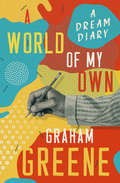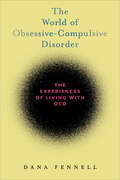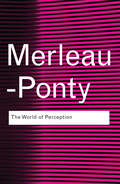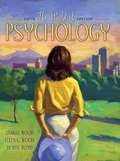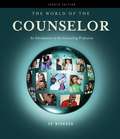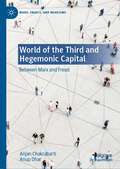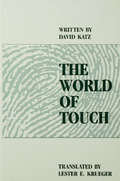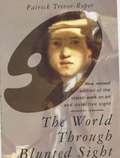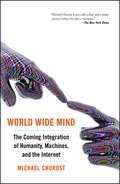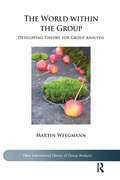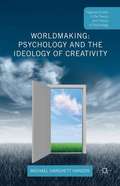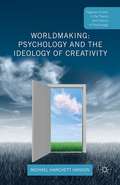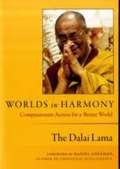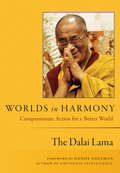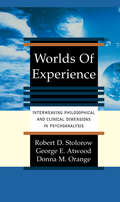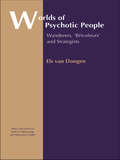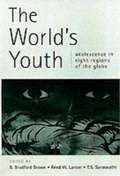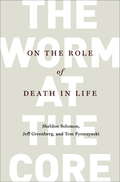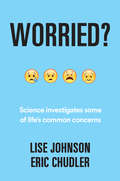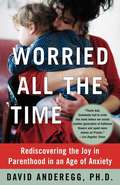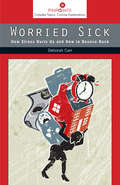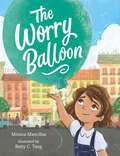- Table View
- List View
A World of My Own: A Dream Diary
by Graham GreeneThe British author shares the “strange . . . inner layers of his playful, guilty imagination” in this glimpse into a brilliant novelist’s subconscious (The New York Times). Culled from nearly eight hundred pages of the author’s “dream diaries” kept between 1965 and 1989, this singular journal reveals “the feverish inner life of an intensely private man, providing an uncanny mirror-image of [his] novelistic obsessions, insecurities, and moral preoccupations” (Publishers Weekly). In what Greene calls My Own World—as opposed to the Common World of shared reality—he accompanies Henry James on a disagreeable riverboat trip to Bogota, is caught in a guerilla crossfire with Evelyn Waugh and W. H. Auden, strolls in the Vatican garden with Pope John Paul II who’s doling out Perugina chocolates like hosts, offers refuge to a suicidal Charlie Chaplin, and stages a disastrous play in blank verse for Elizabeth Taylor and Richard Burton. He also shares his headspace with Goebbels, Castro, Cocteau, Queen Elizabeth, D. H. Lawrence, and talking kittens. And the landscape is just as wide: from Nazi Germany to Haiti to West Africa to Bethlehem 1 AD and to Sweden where he seeks treatment for leprosy. Greene is a criminal, spy, lover, assassin, witness, and writer. Encompassing life, death, war, feuds, and career, and alternately absurdist, frightening, funny, and revealing, these fertile imaginings—many of which found their way into Greene’s fiction—comprise nothing less than “an alternate autobiography . . . a uniquely candid self-portrait” of one of the giants of English literature (Kirkus Reviews).
The World of Obsessive-Compulsive Disorder: The Experiences of Living with OCD
by Dana FennellBeyond trivialization and misunderstanding, the realities of people experiencing OCD Obsessive-Compulsive Disorder (OCD) affects millions of people worldwide and looms large in popular culture, for instance when people quip about being “so OCD.” However, this sometimes has little relation to the actual experiences of people diagnosed with the disorder. In The World of Obsessive-Compulsive Disorder, Dana Fennell explores the lives of people who have OCD, giving us fresh insight into a highly misunderstood, trivialized, and sometimes stigmatized mental disorder that has no surefire cure. Drawing primarily on interviews with people who have OCD, Fennell shows us the diversity of ways the disorder manifests, when and why people come to perceive themselves as having a problem, what treatment options they pursue, and how they make sense of and manage their lives. From those who have obsessions about their sexuality and relationships, to those who check repeatedly to make sure they have not caused harm, she sheds light on the hopes, expectations, and difficulties that people with OCD encounter. Fennell reveals how people cope in the face of this misunderstood disorder, including how they manage the barriers they face in the workplace and society. An eye-opening read, The World of Obsessive-Compulsive Disorder encourages us to consider, empathize with, and take steps to improve the lives of people with mental health issues.
The World of Perception
by Maurice Merleau-Ponty'In simple prose Merleau-Ponty touches on his principle themes. He speaks about the body and the world, the coexistence of space and things, the unfortunate optimism of science – and also the insidious stickiness of honey, and the mystery of anger.' - James ElkinsMaurice Merleau-Ponty was one of the most important thinkers of the post-war era. Central to his thought was the idea that human understanding comes from our bodily experience of the world that we perceive: a deceptively simple argument, perhaps, but one that he felt had to be made in the wake of attacks from contemporary science and the philosophy of Descartes on the reliability of human perception.From this starting point, Merleau-Ponty presented these seven lectures on The World of Perception to French radio listeners in 1948. Available in a paperback English translation for the first time in the Routledge Classics series to mark the centenary of Merleau-Ponty’s birth, this is a dazzling and accessible guide to a whole universe of experience, from the pursuit of scientific knowledge, through the psychic life of animals to the glories of the art of Paul Cézanne.
The World of Psychology (5th edition)
by Samuel E. Wood Ellen Green Wood Denise BoydThe World of Psychology provides superior pedagogical support while making the connection between the scientific principles of psychology and the everyday lives of today's diverse student audience.
The World Of The Counselor: An Introduction To The Counseling Profession
by Edward S. NeukrugDescribed by many as a comprehensive, yet fun and easy-to-read introductory text, THE WORLD OF THE COUNSELOR offers students an overview of the counseling profession. <P><P>Structured around the CACREP core curriculum areas, students will gain an understanding of the professional identity of the counselor; examine the history and current trends of the profession; review important standards such as ethics, credentialing, accreditation, and multicultural and advocacy competencies; and learn basic content related to topics such as counseling theory, counseling skills, group work, family counseling, consultation, supervision, social and cultural issues, normal development and psychopathology, career development, research, and assessment.
World of the Third and Hegemonic Capital: Between Marx and Freud (Marx, Engels, and Marxisms)
by Anjan Chakrabarti Anup DharThis book brings together Marxian philosophy and Lacanian psychoanalysis to argue that the hegemonic form of global capital is founded on the foreclosure of class and world of the third. The authors counterpose the world of the third to the mainstream notion of the third world, seen as a lacking other in desperate need of aid and development. Thus, for them, the hegemonic form of global capital is engendered through the foregrounding of the poor, victim third world and the foreclosure of the non-capitalist world of the third. Building on what they characterize as an ab-original reading of Marxian historical materialism and the Lacanian real, the authors seek to conceptualize a counter-hegemonic revolutionary subject as a basis for postcapitalist alternatives to the hegemonic form of global capital.
The World of Touch
by David KatzFor the first time, David Katz's classic monograph The World of Touch has been translated into English. Regarded as one of the premiere experimental psychologists, Katz vigorously opposed the atomism and "tachistoscopic" mentality typical of the sensory psychology of his day. In The World of Touch, Katz sought to dispel the invidious distinction between the supposedly higher (e.g., vision, audition) and lower (e.g., touch) senses. To help touch regain its original prominence in the field, Katz demonstrated, through very simple, yet creative experiments, how fascinating the abilities of touch are, and how valuable the tactual stimulus can be in specifying objects, surfaces, substances, and events. In addition, Katz emphasized the importance of higher-order invariants in the perception of objects, and the holistic quality of perception in time as well as space.
The World Through Blunted Sight: An Inquiry into the Influence of Defective Vision on Art and Character
by Patrick Trevor-RoperA British ophthalmologist discusses his impressions of visually-impaired artists, including a number of the Impressionists.
World Wide Mind: The Coming Integration of Humans and Machines
by Michael ChorostWhat if digital communication felt as real as being touched? This question led Michael Chorost to explore profound new ideas triggered by lab research around the world, and the result is the book you now hold. Marvelous and momentous, World Wide Mind takes mind-to-mind communication out of the realm of science fiction and reveals how we are on the verge of a radical new understanding of human interaction. Chorost himself has computers in his head that enable him to hear: two cochlear implants. Drawing on that experience, he proposes that our Paleolithic bodies and our Pentium chips could be physically merged, and he explores the technologies that could do it. He visits engineers building wearable computers that allow people to be online every waking moment, and scientists working on implanted chips that would let paralysis victims communicate. Entirely new neural interfaces are being developed that let computers read and alter neural activity in unprecedented detail. But we all know how addictive the Internet is. Chorost explains the addiction: he details the biochemistry of what makes you hunger to touch your iPhone and check your email. He proposes how we could design a mind-to-mind technology that would let us reconnect with our bodies and enhance our relationships. With such technologies, we could achieve a collective consciousness--a World Wide Mind. And it would be humankind's next evolutionary step. With daring and sensitivity, Chorost writes about how he learned how to enhance his own relationships by attending workshops teaching the power of touch. He learned how to bring technology and communication together to find true love, and his story shows how we can master technology to make ourselves more human rather than less. World Wide Mind offers a new understanding of how we communicate, what we need to connect fully with one another, and how our addiction to email and texting can be countered with technologies that put us--literally--in each other's minds.
The World within the Group: Developing Theory for Group Analysis (The New International Library of Group Analysis)
by Martin WeegmannThe World within the Group is an original and ambitious endeavour to connect group analysis to philosophy, history, and modern social theory. The book argues that group analysis needs theoretical renewal to remain relevant, and that philosophy is a valuable resource for such thinking. In particular, the work of three philosophers is examined: Nietzsche, Dewey, and Gadamer, each being associated with "pragmatic-perspective" inquiry. The author demonstrates that group analysis is compatible with such inquiry, and that we understand and intervene from within the horizon of specific traditions of training and theory. Group analysis typifies an unremitting relational stance, valuing openness of dialogue, and moving in and out of the perspectival worlds of the participants. The book also offers a re-formulation of the concept of social unconscious, seen as a discursive world of production and articulation. Drawing on contemporary social theories, it chimes with the spirit of Elias's historical approach.
The Worldly Philosophers: The Lives, Times and Ideas of the Great Economic Thinkers
by Robert HeilbronerAdam Smith, Malthus, David Ricardo, Karl Marx, Thorstein Veblen, John Maynard Keynes, and more...
Worldmaking: Psychology and the Ideology of Creativity (Palgrave Studies in the Theory and History of Psychology)
by Michael Hanchett HansonWorldmaking
Worldmaking: Psychology and the Ideology of Creativity (Palgrave Studies in the Theory and History of Psychology)
by Michael Hanchett HansonMichael Hanchett Hanson weaves together the history of the development of the psychological concepts of creativity with social constructivist views of power dynamics and pragmatic insights. He provides an engaging, thought-provoking analysis to interest anyone involved with creativity, from psychologists and educators to artists and philosophers.
Worlds in Harmony: Compassionate Action For A Better World
by Daniel Goleman Dalai LamaRe-released in time when the relations between China and Tibet and the recent atrocities once again receive close scrutiny in the world media, "Worlds in Harmony" explores the nature of suffering and its release through compassionate action. Its main focus is on the insight that a deep awareness of our shared desire to avoid pain leads to awareness of our responsibility to relieve others of suffering. One of the Dalai Lama's most striking qualities is his genuine interest in western scientific and social thought. He firmly believes that if Buddhism is to have relevance in today's world, it must be flexible and dynamic, able to take in new ideas and transform itself to new situations. By addressing wide-ranging issues like the environmental destruction, political oppression and torture, the nature of anger, and the application of Buddhist principles in the West, "Worlds in Harmony" integrates timeless Buddhist insights with modern Western psychological theory. It offers the reader deep insights into the relation between awareness and right action, bridging personal consciousness and global concerns. By stating that insight is of no use unless it results in action, the Dalai Lama teaches ways of being, thinking, and acting in the world that are based on equanimity and deep understanding.
Worlds in Harmony: Compassionate Action for a Better World
by Daniel Goleman The Dalai LamaOne of the Dalai Lama's most striking qualities is his genuine interest in Western scientific and social thought. <P><P>He firmly believes that if Buddhism is to have relevance today, it must be flexible and dynamic, able to take in new ideas and adapt to new situations. In Worlds in Harmony, he combines timeless Buddhist teachings with modern Western psychological theory to address such diverse issues as environmental destruction, political oppression, the nature of anger, and the application of Buddhist principles in the West. Writing that insight is of no use unless it results in action, he offers new ways of being, thinking, and acting in the world that are based on equanimity and deep understanding. Worlds in Harmony is a timely source book on the practice of healing and compassionate action in daily life.
Worlds Of Experience Interweaving Philosophical And Clinical Dimensions In Psychoanalysis: Interweaving Philosophical And Clinical Dimensions In Psychoanalysis
by Donna Orange George Atwood Robert StolorowThe intersubjective perspective regards all psychological processes as emanating from personal interrelatedness. First presented by Robert D. Stolorow in his classic work Faces in a Cloud (1978), it is one of the most powerful concepts to be introduced into the post-Freudian era. In Worlds of Experience, Dr. Stolorow and two eminent colleagues elaborate on intersubjectivity, going beyond the clinical and theoretical questions of earlier work to explore the philosophical underpinnings of psychoanalytic theory and practice. The culmination of three decades of collaborative work, this book will be essential reading for academics, students, and clinicians.
Worlds of Psychotic People: Wanderers, 'Bricoleurs' and Strategists (Theory and Practice in Medical Anthropology and International Health #10)
by Els Van DongenWorlds of Psychotic People brings a fresh twenty-first century voice to the lives of those with serious psychological disorders, focusing on the manner in which psychiatric patients experience their subjective worlds. Based on ethnographic research gathered at the psychiatric hospital of Saint Anthony's in the Netherlands over a period of five years, it seeks to describe from the perspective of the mental patient some of the fears and hopes that mark an individual's encounter with the fixed reality-structures of a clinical mental ward.
The Worlds of Renaissance Melancholy
by Angus GowlandAngus Gowland investigates the theory of melancholy and its many applications in the Renaissance by means of a wide-ranging contextual analysis of Robert Burton's encyclopaedic Anatomy of Melancholy (first published in 1621). Approaching the Anatomy as the culmination of early modern medical, philosophical and spiritual inquiry about melancholy, Gowland examines the ways in which Burton exploited the moral psychology central to the Renaissance understanding of the condition to construct a critical vision of his intellectual and political environment. In the first sustained analysis of the evolving relationship of the Anatomy (in the various versions issued between 1621 and 1651) to late Renaissance humanist learning and early-seventeenth century England and Europe, Gowland corrects the prevailing view of the work as an unreflective digest of other authors' opinions, and reveals the Anatomy's character as a polemical literary engagement with the live intellectual, religious and political issues of its day.
The World's Youth: Adolescence in Eight Regions of the Globe
by B. Bradford Brown Reed W. Larson T. S. SaraswathiThe life stage of adolescence now occurs in most corners of the world, but it takes different forms in different regions. Scholars from eight regions of the world describe the distinct nature of adolescence, drawing on research to address standard topics regarding this age and show how it has a different effect across societies. As a whole, the book depicts how rapid global change is dramatically altering the experience of the adolescent transition, creating new opportunities and challenges for adolescents, parents, teachers, and professionals.
The Worm at the Core: On the Role of Death in Life
by Jeff Greenberg Sheldon Solomon Tom PyszczynskiA transformative, fascinating theory--based on robust and groundbreaking experimental research--reveals how our unconscious fear of death powers almost everything we do, shining a light on the hidden motives that drive human behavior More than one hundred years ago, the American philosopher William James dubbed the knowledge that we must die "the worm at the core" of the human condition. In 1974, cultural anthropologist Ernest Becker won the Pulitzer Prize for his book The Denial of Death, arguing that the terror of death has a pervasive effect on human affairs. Now authors Sheldon Solomon, Jeff Greenberg, and Tom Pyszczynski clarify with wide-ranging evidence the many ways the worm at the core guides our thoughts and actions, from the great art we create to the devastating wars we wage. The Worm at the Core is the product of twenty-five years of in-depth research. Drawing from innovative experiments conducted around the globe, Solomon, Greenberg, and Pyszczynski show conclusively that the fear of death and the desire to transcend it inspire us to buy expensive cars, crave fame, put our health at risk, and disguise our animal nature. The fear of death can also prompt judges to dole out harsher punishments, make children react negatively to people different from themselves, and inflame intolerance and violence. But the worm at the core need not consume us. Emerging from their research is a unique and compelling approach to these deeply existential issues: terror management theory. TMT proposes that human culture infuses our lives with order, stability, significance, and purpose, and these anchors enable us to function moment to moment without becoming overwhelmed by the knowledge of our ultimate fate. The authors immerse us in a new way of understanding human evolution, child development, history, religion, art, science, mental health, war, and politics in the twenty-first century. In so doing, they also reveal how we can better come to terms with death and learn to lead lives of courage, creativity, and compassion. Written in an accessible, jargon-free style, The Worm at the Core offers a compelling new paradigm for understanding the choices we make in life--and a pathway toward divesting ourselves of the cultural and personal illusions that keep us from accepting the end that awaits us all.
Worried?: An Evidence-based Investigation Of Some Of Life's Common Concerns
by Lise A. Johnson Eric ChudlerHow scientific reasoning explains our most common daily fears—from germs to natural disasters and everything in between. Quick--what do you worry about most? Your cell phone giving you cancer? The public bathroom you’re using being dirty? GMOs in your food? An asteroid strike? Something else? In this witty and evidenced-based book, Lise Johnson and Eric Chudler get to the root of our worries, all the while using science to help tame the anxiety beast. News media, social media, and every mom blog in the world are continuously flagging new things for you to worry about. From obsessing over Lyme disease-infested ticks to worrying about amusement park safety, no-one is immune to the pervasive effects of anxiety brought on by normal, everyday activity. Each topic in this wide-ranging book is subjected to scientific scrutiny, and assigned a place on the “worry index,” with the authors concluding the only things worth worrying about are those those that can cause significant harm, are likely to happen, and are (somewhat) preventable. Whether you are a constant worrier or a stick-your-head-in-the-sand-and-hope-for-the best sort of person, you’ll find something to love in this witty and informative book.
Worried All the Time
by David AndereggA much-needed book for parents about themselves. In the tradition of Dr. Benjamin Spock, who in 1946 revolutionized parenting with the famous opening words of his classic child-rearing guide, "You know more than you think you know," child and family therapist David Anderegg reminds contemporary parents that "parenting is not rocket science. It's not even Chem 101." So why do those of us with children worry so much? Whether they're thinking about school violence or getting a child into the right college, American moms and dads are a pretty worried crowd. Even though most American families are safer and healthier today than at any other time in our history, studies show that parental worrying has, in recent years, reached an all-time high. In Worried All the Time, Dr. Anderegg draws on social science research and his more than twenty years' experience as a therapist treating both parents and their children to clarify facts and fantasies about kids' lives today and the key issues that preoccupy parents. In the process, he offers a comforting and useful message: Parents are suffering needlessly -- and there are things they can do to take the edge off and focus on what their children really need. In Worried All the Time, Dr. Anderegg identifies some of the causes of worry in contemporary American families, including fewer children, exaggerated fear of competition, and overblown media reports of children at risk. Anderegg calls this the "tabloidization of children" and critiques the fashion for media portrayals of "children in crisis." One at a time, he takes on the hot-button issues of our times: the use of day care and nannies overexposure to media school violence overscheduling experimentation with drugs and looks a little closer to see the facts and the fantasies beneath the hysteria. Calling himself a "crisis agnostic," Anderegg persuasively argues that needless worry has negative consequences for families and for our culture as a whole. The cardinal rules of good parenting -- moderation, empathy, and temperamental accommodation with one's child -- are simple, he says, and are not likely to be improved upon by the latest scientific findings. Anderegg helps parents to understand the difference between wise vigilance and potentially crippling anxiety and to gain the confidence to trust their own common sense.
The Worried Child: Recognizing Anxiety in Children and Helping Them Heal
by Paul FoxmanThe author discusses different anxiety disorders in children and how to treat them.
Worried Sick: How Stress Hurts Us and How to Bounce Back
by Deborah CarrComments like "I'm worried sick" convey the conventional wisdom that being "stressed out" will harm our health. Thousands of academic studies reveal that stressful life events (like a job loss), ongoing strains (like burdensome caregiving duties), and even daily hassles (like traffic jams on the commute to work) affect every aspect of our physical and emotional well-being. Cutting through a sea of scientific research and theories, Worried Sick answers many questions about how stress gets under our skin, makes us sick, and how and why people cope with stress differently. Included are several standard stress and coping checklists, allowing readers to gauge their own stress levels.We have all experienced stressful times--maybe a major work deadline or relocating cross-country for a new job--when we came out unscathed, feeling not only emotionally and physically healthy, but better than we did prior to the crisis. Why do some people withstand adversity without a scratch, while others fall ill or become emotionally despondent when faced with even a seemingly minor hassle? Without oversimplifying the discussion, Deborah Carr succinctly provides readers with key themes and contemporary research on the concept of stress. Understanding individuals' own sources of strength and vulnerability is an important step toward developing personal strategies to minimize stress and its unhealthy consequences. Yet Carr also challenges the notion that merely reducing stress in our lives will help us to stay healthy. Many of the stressors that we face in everyday life are not our problems alone; rather, they are symptoms of much larger, sweeping problems in contemporary U.S. society.To readers interested in the broad range of chronic, acute, and daily life stressors facing Americans in the twenty-first century, as well as those with interest in the many ways that our physical and emotional health is shaped by our experiences, this brief book will be an immediate and quick look at these significant issues.View a three minute video of Deborah Carr speaking about Worried Sick.
The Worry Balloon
by Mónica MancillasOn the first day of school, Isla’s mind plays the what if game. Scary thoughts come, the world goes dark, andeverything feels stormy. With Mami at her side, Isla takes a deep breath and blows her worries away in a big balloon. But as school gets closer, Isla’s worries come back like a tornado. Mami encourages her to imagine something happy, and Isla remembers there’s nothing she can’t handle.The storm might come again, but for now, her mind is quiet.In this thoughtful and reassuring picture book, Mónica Mancillas’s text and Betty C. Tang’s illustrations show how one child experiences anxiety and worry, providing different tools to practice mindfulness and strengthen one’s mental health.
